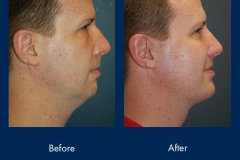FACIAL IMPLANTS
Chin Implants
Some people have a "weak" or receding chin, which is a hereditary characteristic. A receding chin can make a person's profile look out of balance. It can make the nose look too big and it can also detract from an otherwise attractive neckline.
Chin augmentation can correct all of the above with a very simple and quick procedure that involves placing an implant in the chin to give the chin adequate projection. The implant gives the chin and jaw a smoother and stronger outline, making the face and neck more harmonious and attractive in composition.
The type of implant we use is made of a soft silastic material that has the same consistency as the natural chin tissues so that from the outside one cannot detect the presence of an implant and the chin is normal to touch. The implant does not move or shift once it is placed correctly and healing has taken place. After a few months, most individuals forget that there is an implant in the chin.
The implant is inserted through a very small incision in the natural crease under the chin. A chin implant can be performed at the same time as a rhinoplasty (nose surgery), a facelift, or by itself as an independent procedure. Healing time to look presentable is 3 to 5 days.
Cheek Implants
The cheek implant procedure is performed to correct a naturally flat cheekbone area or to correct a sunken cheek appearance that frequently develops with age or after an injury.
There are two types of cheek implants. A malar implant results in more prominent or high cheekbones, whereas a submalar implant corrects the sunken cheek appearance. Both are performed under twilight anesthesia. The implants are placed through tiny incisions inside the mouth under the upper lip on each side.
Healing time is 3 to 5 days to allow swelling to recede. There is usually no bruising. The implants are made of a soft silastic material that carries no risk of rejection. These anatomical implants produce a very natural appearance.

